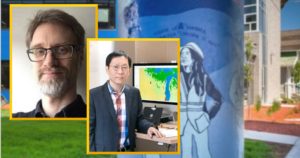Art, learning, and water all intersect in Milwaukee, thanks to a new $2.8 million grant from the National Science Foundation.
Ryan Holifield, an associate professor of geography at UWM, is the principal investigator on the four-year grant that aims to marry art and science to promote awareness among Milwaukee residents about the role of water in their city. The grant will cover four main areas:
1. Expand the reach of the WaterMarks Project.
In 2014, artist Mary Miss, who also helped create the Milwaukee RiverWalk in the 1990s, was asked to develop a community art project in Milwaukee highlighting the role of water in the city. The result was WaterMarks, a series of markers in strategic locations around Milwaukee that are attached to programming highlighting a specific aspect of water – its role in industry, for example, or how Milwaukee manages stormwater runoff.
The markers are in the shape of letters and pulse with light whenever the city is expected to receive heavy rainfall. They serve as a reminder to residents to limit their water usage during those times.
So far, there are markers in several locations around the city, including the letter “A” at the United Community Center Acosta Middle School. Accompanying the markers are works by local artists meant to inspire and spark curiosity in people who view them.
“The funding for this grant period would cover about six new (WaterMarks) sites. The ultimate goal is to try and get this to about 30 across the whole city,” Holifield said. “The idea is to build partnerships with local artists, who will be generating the ideas (for art projects). For example, at Acosta Middle School … there are some art projects that were conducted by the children and led by local artists around that site.”
2. Establish a community-university working group to develop a guide to sustain the program over time and expand it to other cities.
Milwaukee has striven to establish itself as a leader in water research. UWM boasts the nation’s only School of Freshwater Sciences and community leaders have worked hard to revitalize the areas surrounding the Milwaukee River. In many ways, Holifield said, Milwaukee is the ideal city for a pilot program like this.
“Our hope is, not only can this be something that becomes an important part of Milwaukee, and ideally, something Milwaukee is known for, but something other cities can do similarly but dealing with their own issues,” Holifield said.
The art associated with such markers would also be specific to its location, he added. What might the art look like in a city like New Orleans or Phoenix? What water issues would those cities choose to highlight?
3. Evaluate the WaterMarks program.
The WaterMarks project is not just about water and art; it’s about learning and stewardship as well.
“One of the central programming activities is neighborhood walks led by teams of artists and scientists,” Holifield said. “You’d learn about green infrastructure and various problems, like flooding, that the neighborhood (around the marker) is facing. The walking tour would also (highlight) some artistic projects residents have done.”
4. Research how people learn through this type of programming.
How well will these curated walk-and-talks work? Holifield’s co-principal investigator, associate professor of geography Woonsup Choi, explained how the group plans to find out.
“We’ll try to examine it by having people drawing some maps or doing some sketch or some other kind of hands-on activity,” Choi explained. “Then we’ll examine how people do that activity differently depending on their background and on the location of the activity. We’ll try to add to existing theories about informal science learning.”
“Informal science learning” refers to how people are exposed to STEM concepts outside of a classroom or structured teaching environment. Museums, aquariums, zoos – these are all prime places that focus on informal science learning, and educators want to kwant to know more about how to engage the community in STEM issues that affect them.
But museums and aquariums are out of reach for many city residents. The WaterMarks project wants to address that lack of access. Holifield and Choi hope the program will help them understand how people learn differently through engagement with visual art and artistic practices. And, the project is an important step towards environmental justice and equity, Choi said.
“It’s happening in your neighborhood so you can easily participate and know who the other participants are, rather than going to a museum far away – or never going to a museum at all,” he said.
“The idea is to make it as inclusive and diverse and representative as possible, and to bring these learning experiences to the neighborhoods instead of bringing the neighborhoods to a central location,” Holifield noted.
Hopes for the future
Holifield and Choi hope that the grant will impact how Milwaukeeans think about the water around them. There are all sorts of problems facing the city’s water infrastructure, from lead pipes contaminating drinking water to deteriorating sewer systems. The first step in fixing those problems is building community awareness.
“The idea is that these art-science collaborations can help people become active and involved in ways that just traditional, technical approaches might not be enough to do,” Holifield said.
The grant, awarded from the Advancing Informal STEM Learning program of the National Science Foundation, supports a UWM team including Holifield; Choi; Laurie Marks (Center for Community-Based Learning, Leadership, and Research); Jessica Meuninck-Ganger (Peck School of the Arts); and Deidre Peroff (UW-Sea Grant/School of Freshwater Sciences), in partnership with City as Living Laboratory (CALL) in New York; the Center for Research and Evaluation at the Center of Science and Industry (COSI) in Columbus, Ohio; and UW-Sea Grant.
By Sarah Vickery, College of Letters & Science
